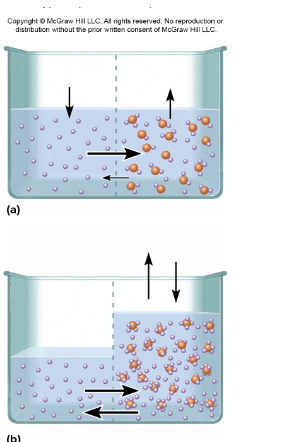QUESTIONS
Question 1
Which type of movement occurs without the use of energy (ATP), and moves molecules from high concentration to low concentration? Select all that apply.
- Osmosis
- Active Transport
- Diffusion
Question 2
Both intracellular fluid (ICF) and extracellular fluid (ECF) will contain similar solutes and concentrations. This statement is
- True
- False
Question 3
What type of passive transport is shown?
Figure 3.14 Side A and Side B are separated by a selectively permeable membrane. Solute molecules are observed in Side B and cannot pass through the membrane. After 30 minutes, the volume of Side A is decreased and the volume in Side B is increased.

- Facilitated Diffusion
- Simple Diffusion
- Osmosis
Question 4
Watch the following video and answer the question below.
This video explains the sodium-potassium pump. What causes the sodium ions to move out of the cell? Select all that apply.
- ATP becoming ADP
- ADP + PI becoming ATP
- Sodium ions entering the channel
- Potassium ions entering the channel
- Phosphate being released from the protein
Question 5
Watch this video on the effects of tonicity on red blood cells.
What is the effect of a hypertonic solution on red blood cells?
- Shriveling, known as crenation.
- Swelling, and potentially bursting of the cell.
- There will be no change to the red blood cell.
Question 6
Watch the video. Hormones are brought into the cell after a certain number are attached to receptors on the cell surface. The process is best described as.
- Receptor mediated endocytosis.
- Pinocytosis.
- Phagocytosis,
- Exocytosis.
Question 7
Which of the following is not a method by which particles can leave a cell?
- Active transport
- Pinocytosis
- Exocytosis
- Simple diffusion
- Osmosis
Question 8
Which of these is an example of active transport?
- The diffusion of oxygen from a place of high concentration to a place of low concentration.
- The transport of glucose down its concentration gradient.
- The transport of Na+ from a place of low concentration to a place of higher concentration.
- The facilitated diffusion of K+
- The transport of Cl- following its concentration gradient.
Question 9
Two solutions are separated by a selectively permeable membrane. If solution A has a higher concentration of a nonpermeating solute than solution B, then ___________.
- Water will pass down its concentration gradient from solution A to B.
- The solute will pass down its concentration gradient from solution A to B.
- The solute will pass down its concentration gradient from solution B to A.
- Water will pass down its concentration gradient from solution B to A.
- Neither the solute nor water will dilute.
Question 10
A red blood cell is placed in a hypertonic solution. This means the concentration of solutes in the solution is _____________ than the concentration of solutes in the intracellular fluid, and will cause the cell to _________.
Question 11
ATP is consumed when _____________ transfer solutes from one side of the membrane to the other.
Question 12
What do facilitated diffusion and active transport have in common?
- Both involve transport of a solute up its concentration gradient.
- Neither require ATP to function.
- Both involve transport of a solute down its concentration gradient
- Both use channel proteins
- Both involve the use of energy provided by ATP
Question 13
Intracellular fluids is found __________ cells and contains more ______________ ions than extracellular fluid.
ANSWERS
Question 1
Which type of movement occurs without the use of energy (ATP), and moves molecules from high concentration to low concentration? Select all that apply.
- Osmosis
- Active Transport
- Diffusion
Correct answers are bolded. To access all answers, use the purchase button below.
